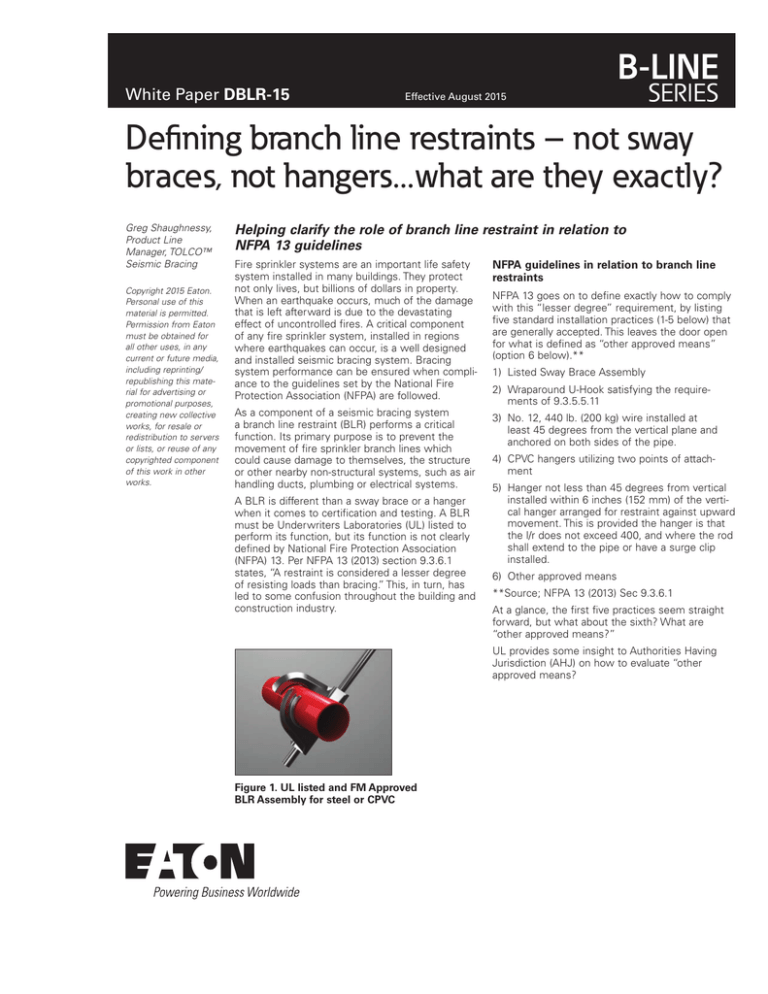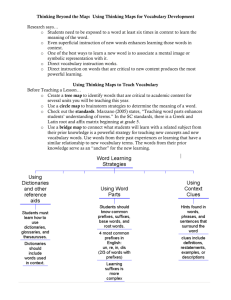
White Paper DBLR-15
Effective August 2015
Defining branch line restraints – not sway
braces, not hangers...what are they exactly?
Greg Shaughnessy,
Product Line
Manager, TOLCO™
Seismic Bracing
Copyright 2015 Eaton.
Personal use of this
material is permitted.
Permission from Eaton
must be obtained for
all other uses, in any
current or future media,
including reprinting/
republishing this material for advertising or
promotional purposes,
creating new collective
works, for resale or
redistribution to servers
or lists, or reuse of any
copyrighted component
of this work in other
works.
Helping clarify the role of branch line restraint in relation to
NFPA 13 guidelines
Fire sprinkler systems are an important life safety
system installed in many buildings. They protect
not only lives, but billions of dollars in property.
When an earthquake occurs, much of the damage
that is left afterward is due to the devastating
effect of uncontrolled fires. A critical component
of any fire sprinkler system, installed in regions
where earthquakes can occur, is a well designed
and installed seismic bracing system. Bracing
system performance can be ensured when compliance to the guidelines set by the National Fire
Protection Association (NFPA) are followed.
As a component of a seismic bracing system
a branch line restraint (BLR) performs a critical
function. Its primary purpose is to prevent the
movement of fire sprinkler branch lines which
could cause damage to themselves, the structure
or other nearby non-structural systems, such as air
handling ducts, plumbing or electrical systems.
A BLR is different than a sway brace or a hanger
when it comes to certification and testing. A BLR
must be Underwriters Laboratories (UL) listed to
perform its function, but its function is not clearly
defined by National Fire Protection Association
(NFPA) 13. Per NFPA 13 (2013) section 9.3.6.1
states, “A restraint is considered a lesser degree
of resisting loads than bracing.” This, in turn, has
led to some confusion throughout the building and
construction industry.
NFPA guidelines in relation to branch line
restraints
NFPA 13 goes on to define exactly how to comply
with this “lesser degree” requirement, by listing
five standard installation practices (1-5 below) that
are generally accepted. This leaves the door open
for what is defined as “other approved means”
(option 6 below).**
1)Listed Sway Brace Assembly
2)Wraparound U-Hook satisfying the requirements of 9.3.5.5.11
3)No. 12, 440 lb. (200 kg) wire installed at
least 45 degrees from the vertical plane and
anchored on both sides of the pipe.
4)CPVC hangers utilizing two points of attachment
5)Hanger not less than 45 degrees from vertical
installed within 6 inches (152 mm) of the vertical hanger arranged for restraint against upward
movement. This is provided the hanger is that
the l/r does not exceed 400, and where the rod
shall extend to the pipe or have a surge clip
installed.
6) Other approved means
**Source; NFPA 13 (2013) Sec 9.3.6.1
At a glance, the first five practices seem straight
forward, but what about the sixth? What are
“other approved means?”
UL provides some insight to Authorities Having
Jurisdiction (AHJ) on how to evaluate “other
approved means?
Figure 1. UL listed and FM Approved
BLR Assembly for steel or CPVC
White Paper DBLR15
Effective August 2015
UL’s “Outline of Investigation for Sway Brace Devices (UL 203A; rev
6 15 2011)” includes a section that addresses products that meet
a lesser degree of performance than those that achieve a listing as
a lateral or longitudinal sway brace fitting or structural attachment.
This creates a new “sub-section” for UL listing called a “Restraint
Device.” Typically, these products will have loads in the range of
approximately 300 lbs. or a lower l/r than its UL listed Sway Brace
counterparts. The L/R or Slenderness Ratio refers to the allowable
length of a rigid brace member. Limitations on length are imposed
due to compressive force that acts on the BLR assembly. Loads
are affected by the length of the brace member of the BLR/ Simply
stated, the longer the brace member is, the lower the ability to
sustain a load.
However, there is a proposed word of caution regarding UL listed
restraint devices. They are stamped with the UL logo and are shown
in the same file as manufacturer- approved “Sway Brace” products,
but are not UL listed to perform the same function.
Generally, these UL listed “Restraint” products should not be used
to brace main or cross main piping. They should only be used as
branch line restraints as their listing indicates. Recent changes to
the UL test procedure have resulted in many manufacturers having
products there were previously listed as a “Sway Brace” to fall into
the new category of “Restraint”. This can create a problem when
contractors install products that were previously UL listed as a lateral
brace, but now are only listed as a restraint. If these products are
installed for a purpose for which they are not listed, it is the same as
installing a non-listed product. AHJ’s should be aware of the latest
UL listings during both the plan review and inspection processes.
Testing Criteria
There are two tests to determine when a product meets the “other
approved means” criterion per NFPA 13 (2013) section 9.3.6.1.
UL 203A test
A “Listed Restraint Assembly” is not one of the five prescribed
methods for compliance within NFPA 13(2013) 9.3.6.1. As noted
in the test criteria below, the load requirements and deformation
requirements are much more relaxed than those of a listed sway
brace device. The load requirements are also much less stringent
than those required for a listing as a hanger. Therefore, this UL listing
as a restraint device does not comply with any of the options 1-5 of
section 9.3.6.1. The listing as a restraint must fall under the (6) “other
approved means” method in NFPA 13, which is open to interpretation by the local authority having jurisdiction. Calculations that show
the load requirements of the system design (similar to “zone of
influence” calculations used with sway braces) should be required.
Along with this, the capacity of the listed restraint assembly must
show the assembly is capable of performing the task it is installed to
do – to restrain a length of branch line piping.
UL Restraint Device Load Test
11.1 R
estraint Devices shall withstand a minimum force of 300
pounds-force (1334 N) without a displacement of no more than
1/2 inch (12.4 mm) in tension and compression when installed
in accordance with the manufacture’s instructions.
estraints Devices installed in accordance with the manufac11.2 R
ture’s installation instructions on the appropriate pipe are to be
installed in a tension-compression test apparatus in a manner
duplicating as closely as possible their intended field installation. Each assembly is then to be subjected to an increasing
compressive load until a load of 300 pound-force (1334 N) or a
greater force specified in the manufacturer’s installation instructions is applied for one minute, in a, manner to evaluate the
restraining feature, and the displacement measures. The load is
then applied in tension and the displacement measured.
Factory Mutual Global (FM) 1950 test
Factory Mutual Global (FM) has a different set of criteria for the
testing of sway brace devices versus branch line restraints. Much
more sophisticated than the UL 203A test, the FM 1950 test uses a
shaker table to test cyclical loading of the products in a sway brace
or BLR assembly. This is similar to the forces the products would
experience during an actual earthquake. During testing, assemblies
are actually installed and tested as an assembly configuration.
Figure 2. UL listed Sway Brace Assembly
2
EATON www.eaton.com
FM 1950 makes no distinction between a “sway brace device” and
a “restraint device” in its testing procedure. There is no minimum
load to achieve during testing. A product is simply tested, and
an approved load is assigned. FM Global publishes load values
applicable to a range of brace angles. The products intended by a
manufacturer to be used as a restraint can be identified by much
lower loads than those products intended for the bracing of sprinkler
main piping. Or, in some cases the name of the product itself might
be the only clue.
White Paper DBLR15
Effective August 2015
Conclusion
About Eaton
Throughout the industry, there is general consensus on the notion
that branch line restraints are critical components of a high performance and NFPA 13-compliant seismic bracing system. Contractors
have five methods specified in NFPA 13 on how to install a functional restraint assembly and a sixth option that opens the door to
“other approved means.” UL has attempted to address the “other
approved means” by developing a set of criteria that is measurably
a “lesser degree of resisting loads than bracing” (NFPA 13; 2013,
9.3.6.1) and has allowed products to be listed in sway brace product
files and bear the UL logo.
Eaton offers a broad range of data center and electrical enclosures,
airflow management solutions and B-Line series support systems,
seismic bracing solutions, electrical enclosures and wireways
designed to save time and deliver a lower total installed cost. The
products offered serve customers in commercial construction, oil
and gas, mining, solar, communications and data centers, and other
markets.
While this may cause some confusion for Authorities Having
Jurisdiction (AHJ) on a product-specific listing, it is a good attempt
to apply a specific set of test criteria to the NFPA 13 definition of a
restraint. Similar to how requirements for sway bracing has evolved,
it is likely that the requirements for Branch Line Restraints will
continue to be redefined and expanded as NFPA 13 evolves through
its revision cycles.
In the meantime, authorities need to understand exactly what is
allowed by the five options in the current NFPA 13 standard as
well as the UL testing and approval processes that manufacturers
apply to their products. The manufacturers of products can only
supply information about their products and the testing of their
products. The manufacturer can offer that a product is listed or not,
or approved or not, to perform certain functions as defined by those
certifications. Contractors can design systems and have their submittals approved by the AHJ. After the systems are installed, contractors
can only say that what they have installed is what was approved in
the submittal or not.
If an installed product is not UL listed as a hanger or a sway brace, then
it is the AHJ, not the manufacturer nor the contractor, who is responsible for defining whether or not the product is compliant with NFPA 13.
For more information on TOLCO seismic bracing, visit
www.cooperbline.com/tolco.
Figure 3. UL listed Branch Line Restraint Assembly
Eaton
1000 Eaton Boulevard
Cleveland, OH 44122
United States
Eaton.com
© 2015 Eaton
All Rights Reserved
Printed in USA
Publication No. DBLR15
August 2015
Eaton’s electrical business is a global leader with expertise in power
distribution and circuit protection; backup power protection; control
and automation; lighting and security; structural solutions and wiring
devices; solutions for harsh and hazardous environments; and engineering services. Eaton is positioned through its global solutions
to answer today’s most critical electrical power management
challenges.
Eaton is a power management company with 2014 sales of $22.6
billion. Eaton provides energy-efficient solutions that help our
customers effectively manage electrical, hydraulic and mechanical
power more efficiently, safely and sustainably. Eaton has approximately 102,000 employees and sells products to customers in more
than 175 countries. For more information, visit www.eaton.com.
Sources
1. N
FPA 13 Automatic Sprinkler Systems Handbook - 2010 edition Jim Lake
2. N
FPA 13 Automatic Sprinkler Systems Handbook - 2013 edition Matthew J. Klaus
3. U
L 203A Outline for the investivation of Sway Braces for Sprinkler
System Piping - 2012 edition
4. F
M Global - Approval Standard for Seismic Sway Braces for
Automatic Sprinkler Systems Class Number 1950 - 2011
Figure 4. UL listed Seismic Brace Structural Attachment
B-Line Division
13201 Dahlia Street, Suite 200
Fontana, CA 92337
United States
Phone: 800-851-7415
www.cooperbline.com/tolco
Eaton is a registered trademark.
All other trademarks are property
of their respective owners.
EATON www.eaton.com
3


